University Mechanical Engineering: DFA Product Study of Wiper Motor
VerifiedAdded on 2022/09/16
|20
|3028
|18
Practical Assignment
AI Summary
This assignment is a comprehensive Design for Assembly (DFA) product study focused on a rear windscreen wiper motor. The study begins with an introduction to the importance of quality and cost efficiency in manufacturing, particularly within the context of competitive industries and the lifecycle of a product. The assignment delves into the DFA methodology, detailing its three main stages: functional analysis, feeding analysis, and fitting analysis. The functional analysis includes examining the product’s functional requirements, defining functional roles, and classifying components based on their contribution to the product's performance. The assignment provides a detailed functional analysis record for the wiper motor, classifying components, and calculating design efficiency. The feeding analysis considers how components are presented to the assembly point, while the fitting analysis assesses the suitability of components within the design. The study also includes component classification for redesign, considering elimination, combination, redesign, and acceptability. The assignment provides detailed data in the form of tables and charts to aid in product analysis and redesign, with a goal of improving product quality and reducing manufacturing costs. The document also discusses the importance of product study, analysis procedure, and redesign approaches to enhance the final product.
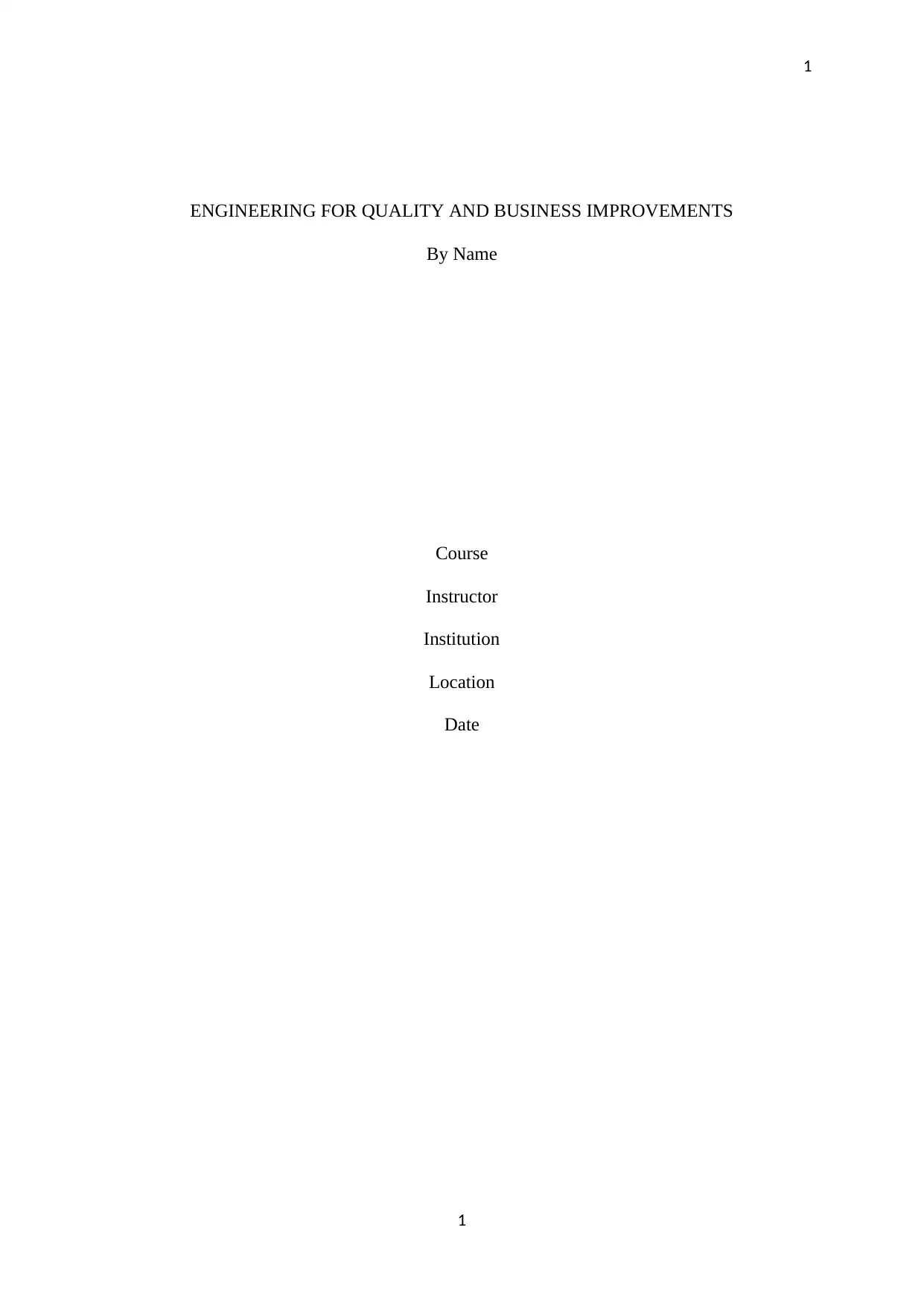
1
ENGINEERING FOR QUALITY AND BUSINESS IMPROVEMENTS
By Name
Course
Instructor
Institution
Location
Date
1
ENGINEERING FOR QUALITY AND BUSINESS IMPROVEMENTS
By Name
Course
Instructor
Institution
Location
Date
1
Paraphrase This Document
Need a fresh take? Get an instant paraphrase of this document with our AI Paraphraser
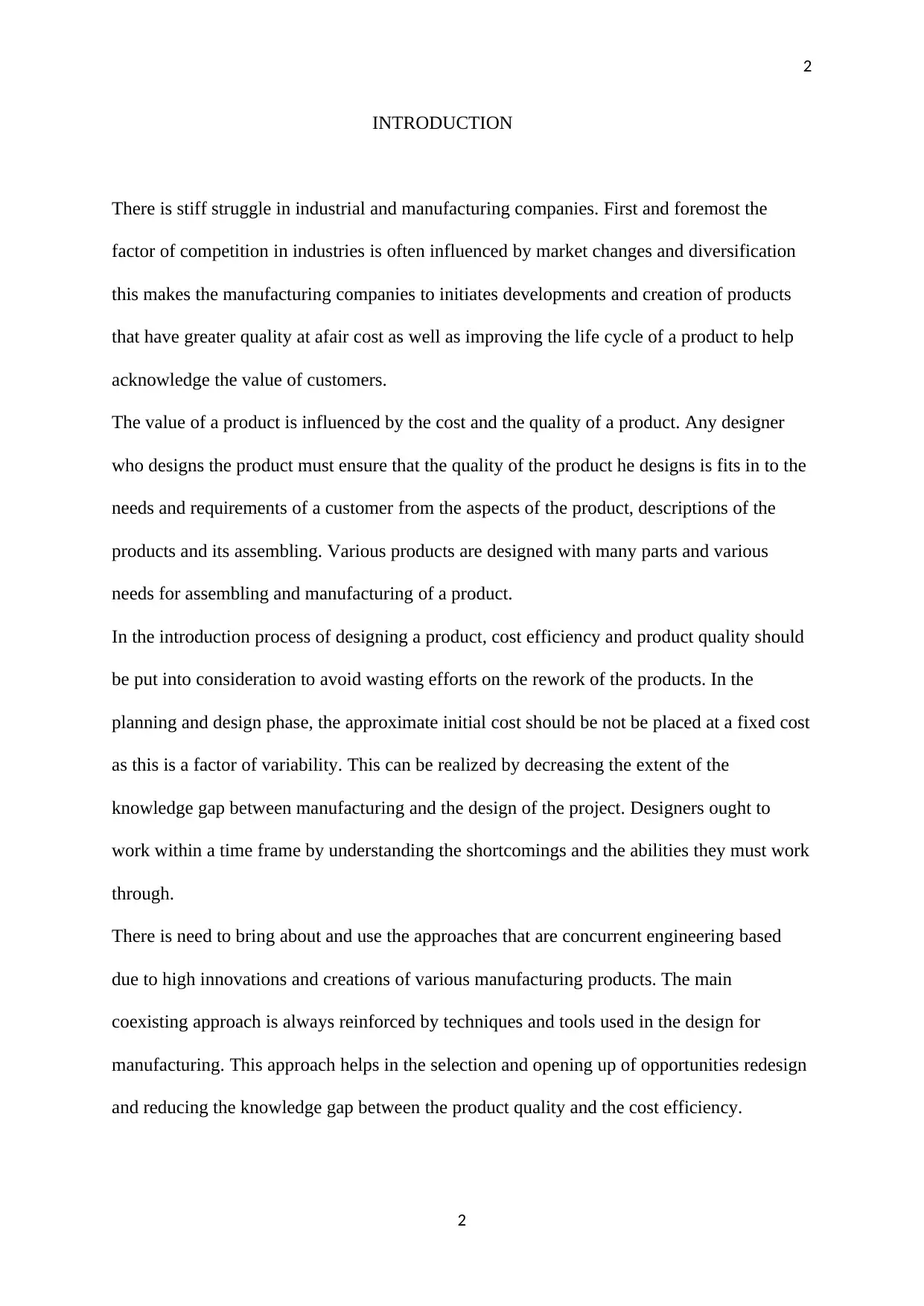
2
INTRODUCTION
There is stiff struggle in industrial and manufacturing companies. First and foremost the
factor of competition in industries is often influenced by market changes and diversification
this makes the manufacturing companies to initiates developments and creation of products
that have greater quality at afair cost as well as improving the life cycle of a product to help
acknowledge the value of customers.
The value of a product is influenced by the cost and the quality of a product. Any designer
who designs the product must ensure that the quality of the product he designs is fits in to the
needs and requirements of a customer from the aspects of the product, descriptions of the
products and its assembling. Various products are designed with many parts and various
needs for assembling and manufacturing of a product.
In the introduction process of designing a product, cost efficiency and product quality should
be put into consideration to avoid wasting efforts on the rework of the products. In the
planning and design phase, the approximate initial cost should be not be placed at a fixed cost
as this is a factor of variability. This can be realized by decreasing the extent of the
knowledge gap between manufacturing and the design of the project. Designers ought to
work within a time frame by understanding the shortcomings and the abilities they must work
through.
There is need to bring about and use the approaches that are concurrent engineering based
due to high innovations and creations of various manufacturing products. The main
coexisting approach is always reinforced by techniques and tools used in the design for
manufacturing. This approach helps in the selection and opening up of opportunities redesign
and reducing the knowledge gap between the product quality and the cost efficiency.
2
INTRODUCTION
There is stiff struggle in industrial and manufacturing companies. First and foremost the
factor of competition in industries is often influenced by market changes and diversification
this makes the manufacturing companies to initiates developments and creation of products
that have greater quality at afair cost as well as improving the life cycle of a product to help
acknowledge the value of customers.
The value of a product is influenced by the cost and the quality of a product. Any designer
who designs the product must ensure that the quality of the product he designs is fits in to the
needs and requirements of a customer from the aspects of the product, descriptions of the
products and its assembling. Various products are designed with many parts and various
needs for assembling and manufacturing of a product.
In the introduction process of designing a product, cost efficiency and product quality should
be put into consideration to avoid wasting efforts on the rework of the products. In the
planning and design phase, the approximate initial cost should be not be placed at a fixed cost
as this is a factor of variability. This can be realized by decreasing the extent of the
knowledge gap between manufacturing and the design of the project. Designers ought to
work within a time frame by understanding the shortcomings and the abilities they must work
through.
There is need to bring about and use the approaches that are concurrent engineering based
due to high innovations and creations of various manufacturing products. The main
coexisting approach is always reinforced by techniques and tools used in the design for
manufacturing. This approach helps in the selection and opening up of opportunities redesign
and reducing the knowledge gap between the product quality and the cost efficiency.
2
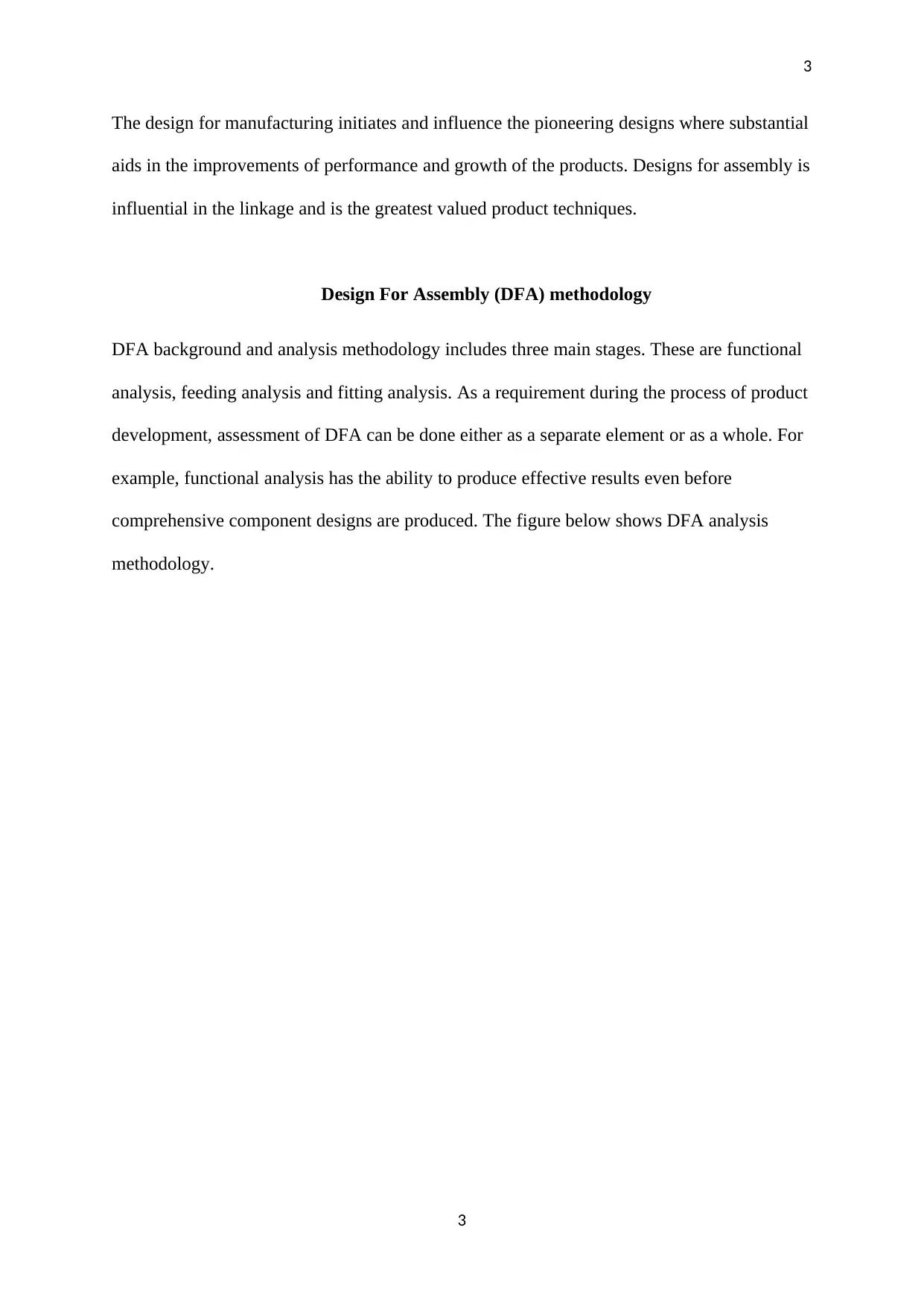
3
The design for manufacturing initiates and influence the pioneering designs where substantial
aids in the improvements of performance and growth of the products. Designs for assembly is
influential in the linkage and is the greatest valued product techniques.
Design For Assembly (DFA) methodology
DFA background and analysis methodology includes three main stages. These are functional
analysis, feeding analysis and fitting analysis. As a requirement during the process of product
development, assessment of DFA can be done either as a separate element or as a whole. For
example, functional analysis has the ability to produce effective results even before
comprehensive component designs are produced. The figure below shows DFA analysis
methodology.
3
The design for manufacturing initiates and influence the pioneering designs where substantial
aids in the improvements of performance and growth of the products. Designs for assembly is
influential in the linkage and is the greatest valued product techniques.
Design For Assembly (DFA) methodology
DFA background and analysis methodology includes three main stages. These are functional
analysis, feeding analysis and fitting analysis. As a requirement during the process of product
development, assessment of DFA can be done either as a separate element or as a whole. For
example, functional analysis has the ability to produce effective results even before
comprehensive component designs are produced. The figure below shows DFA analysis
methodology.
3
⊘ This is a preview!⊘
Do you want full access?
Subscribe today to unlock all pages.

Trusted by 1+ million students worldwide
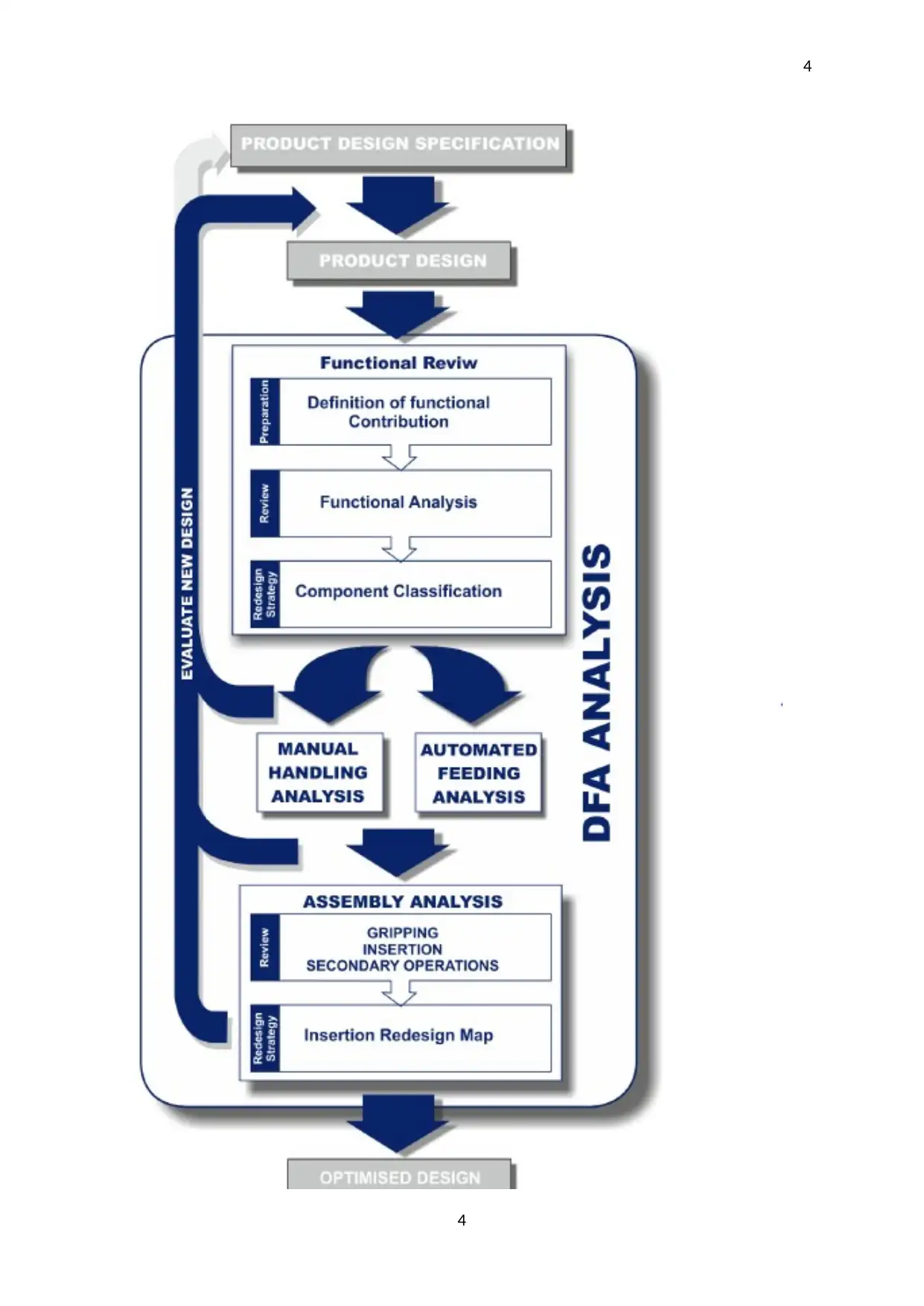
4
4
4
Paraphrase This Document
Need a fresh take? Get an instant paraphrase of this document with our AI Paraphraser
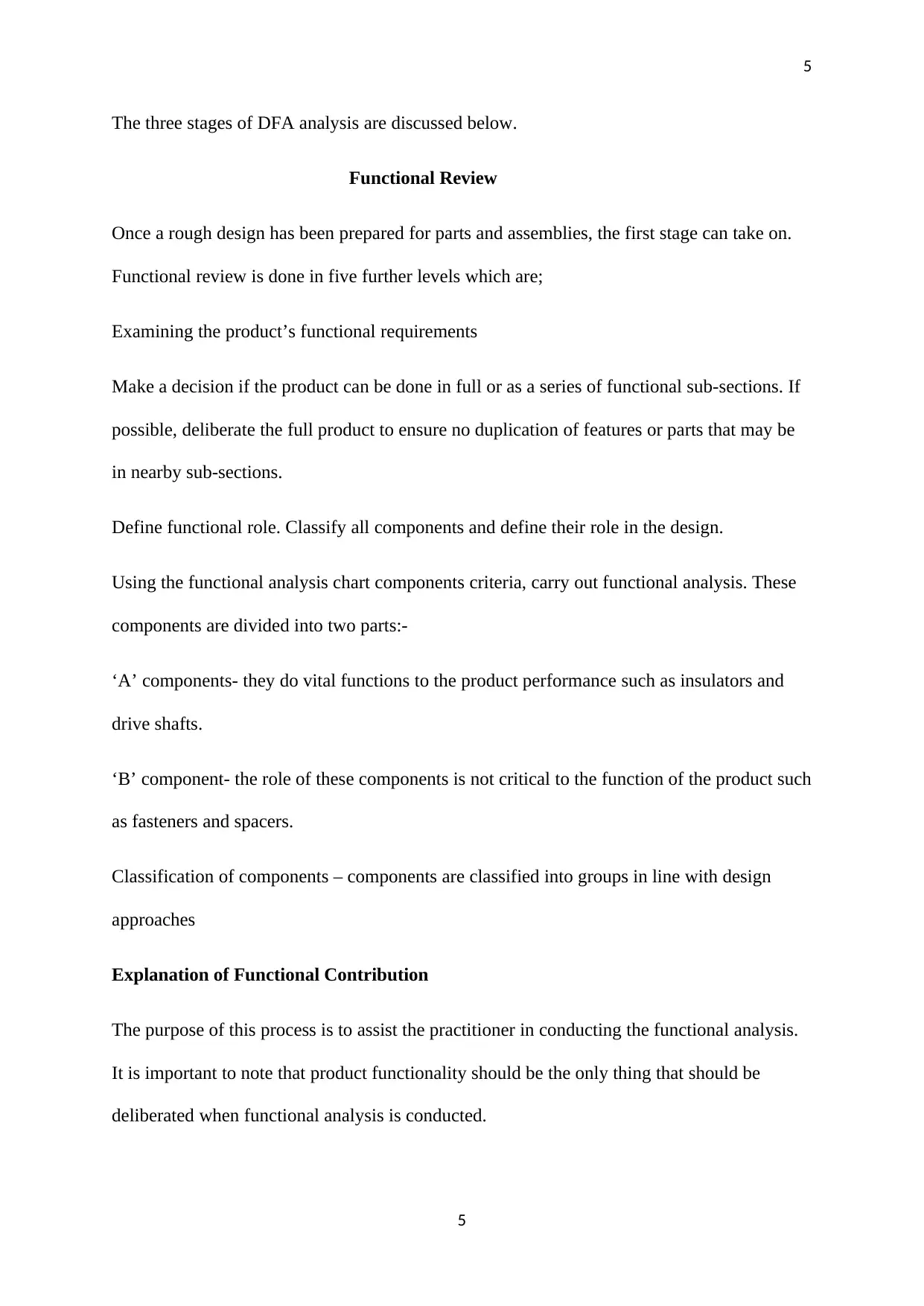
5
The three stages of DFA analysis are discussed below.
Functional Review
Once a rough design has been prepared for parts and assemblies, the first stage can take on.
Functional review is done in five further levels which are;
Examining the product’s functional requirements
Make a decision if the product can be done in full or as a series of functional sub-sections. If
possible, deliberate the full product to ensure no duplication of features or parts that may be
in nearby sub-sections.
Define functional role. Classify all components and define their role in the design.
Using the functional analysis chart components criteria, carry out functional analysis. These
components are divided into two parts:-
‘A’ components- they do vital functions to the product performance such as insulators and
drive shafts.
‘B’ component- the role of these components is not critical to the function of the product such
as fasteners and spacers.
Classification of components – components are classified into groups in line with design
approaches
Explanation of Functional Contribution
The purpose of this process is to assist the practitioner in conducting the functional analysis.
It is important to note that product functionality should be the only thing that should be
deliberated when functional analysis is conducted.
5
The three stages of DFA analysis are discussed below.
Functional Review
Once a rough design has been prepared for parts and assemblies, the first stage can take on.
Functional review is done in five further levels which are;
Examining the product’s functional requirements
Make a decision if the product can be done in full or as a series of functional sub-sections. If
possible, deliberate the full product to ensure no duplication of features or parts that may be
in nearby sub-sections.
Define functional role. Classify all components and define their role in the design.
Using the functional analysis chart components criteria, carry out functional analysis. These
components are divided into two parts:-
‘A’ components- they do vital functions to the product performance such as insulators and
drive shafts.
‘B’ component- the role of these components is not critical to the function of the product such
as fasteners and spacers.
Classification of components – components are classified into groups in line with design
approaches
Explanation of Functional Contribution
The purpose of this process is to assist the practitioner in conducting the functional analysis.
It is important to note that product functionality should be the only thing that should be
deliberated when functional analysis is conducted.
5
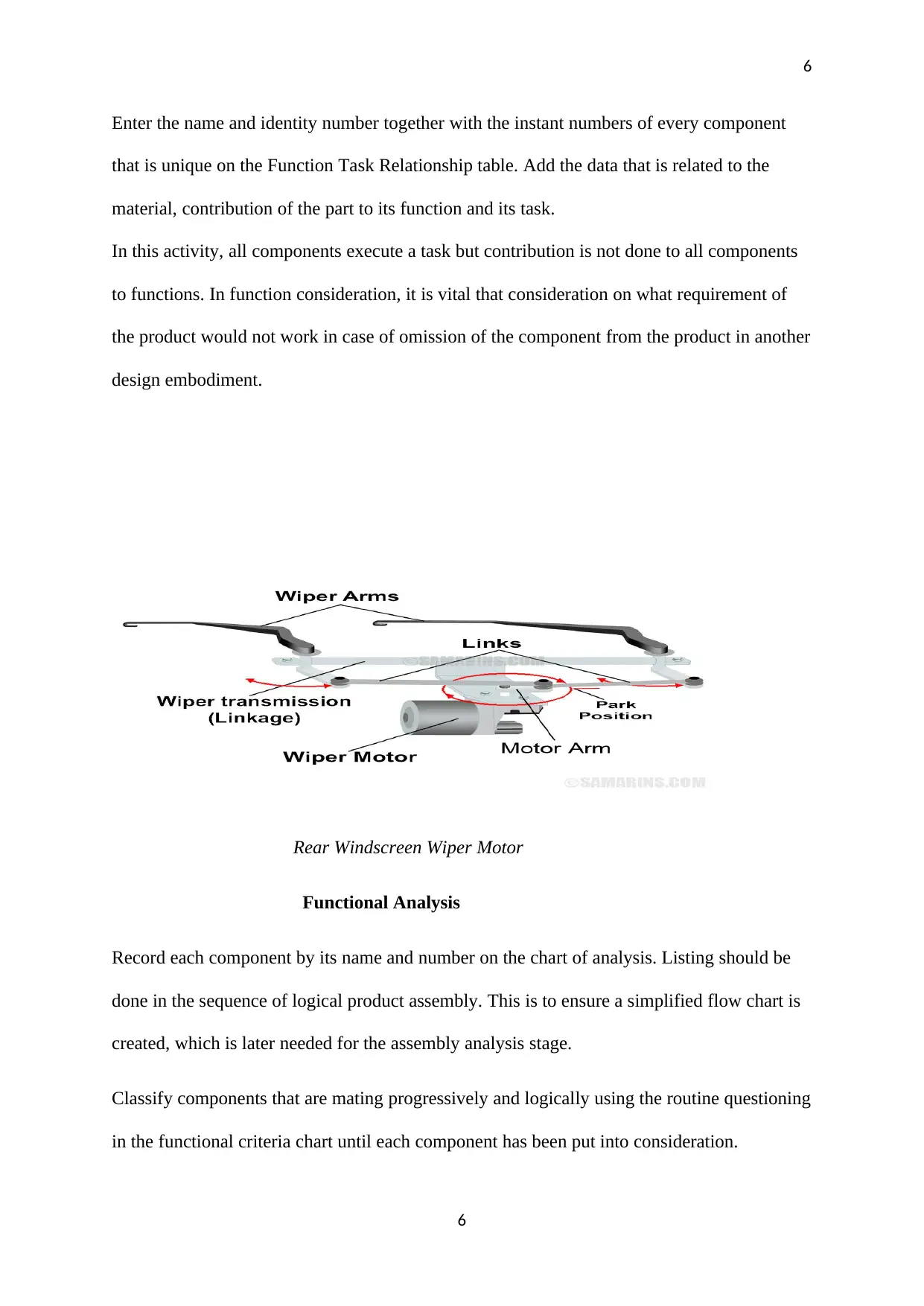
6
Enter the name and identity number together with the instant numbers of every component
that is unique on the Function Task Relationship table. Add the data that is related to the
material, contribution of the part to its function and its task.
In this activity, all components execute a task but contribution is not done to all components
to functions. In function consideration, it is vital that consideration on what requirement of
the product would not work in case of omission of the component from the product in another
design embodiment.
Rear Windscreen Wiper Motor
Functional Analysis
Record each component by its name and number on the chart of analysis. Listing should be
done in the sequence of logical product assembly. This is to ensure a simplified flow chart is
created, which is later needed for the assembly analysis stage.
Classify components that are mating progressively and logically using the routine questioning
in the functional criteria chart until each component has been put into consideration.
6
Enter the name and identity number together with the instant numbers of every component
that is unique on the Function Task Relationship table. Add the data that is related to the
material, contribution of the part to its function and its task.
In this activity, all components execute a task but contribution is not done to all components
to functions. In function consideration, it is vital that consideration on what requirement of
the product would not work in case of omission of the component from the product in another
design embodiment.
Rear Windscreen Wiper Motor
Functional Analysis
Record each component by its name and number on the chart of analysis. Listing should be
done in the sequence of logical product assembly. This is to ensure a simplified flow chart is
created, which is later needed for the assembly analysis stage.
Classify components that are mating progressively and logically using the routine questioning
in the functional criteria chart until each component has been put into consideration.
6
⊘ This is a preview!⊘
Do you want full access?
Subscribe today to unlock all pages.

Trusted by 1+ million students worldwide
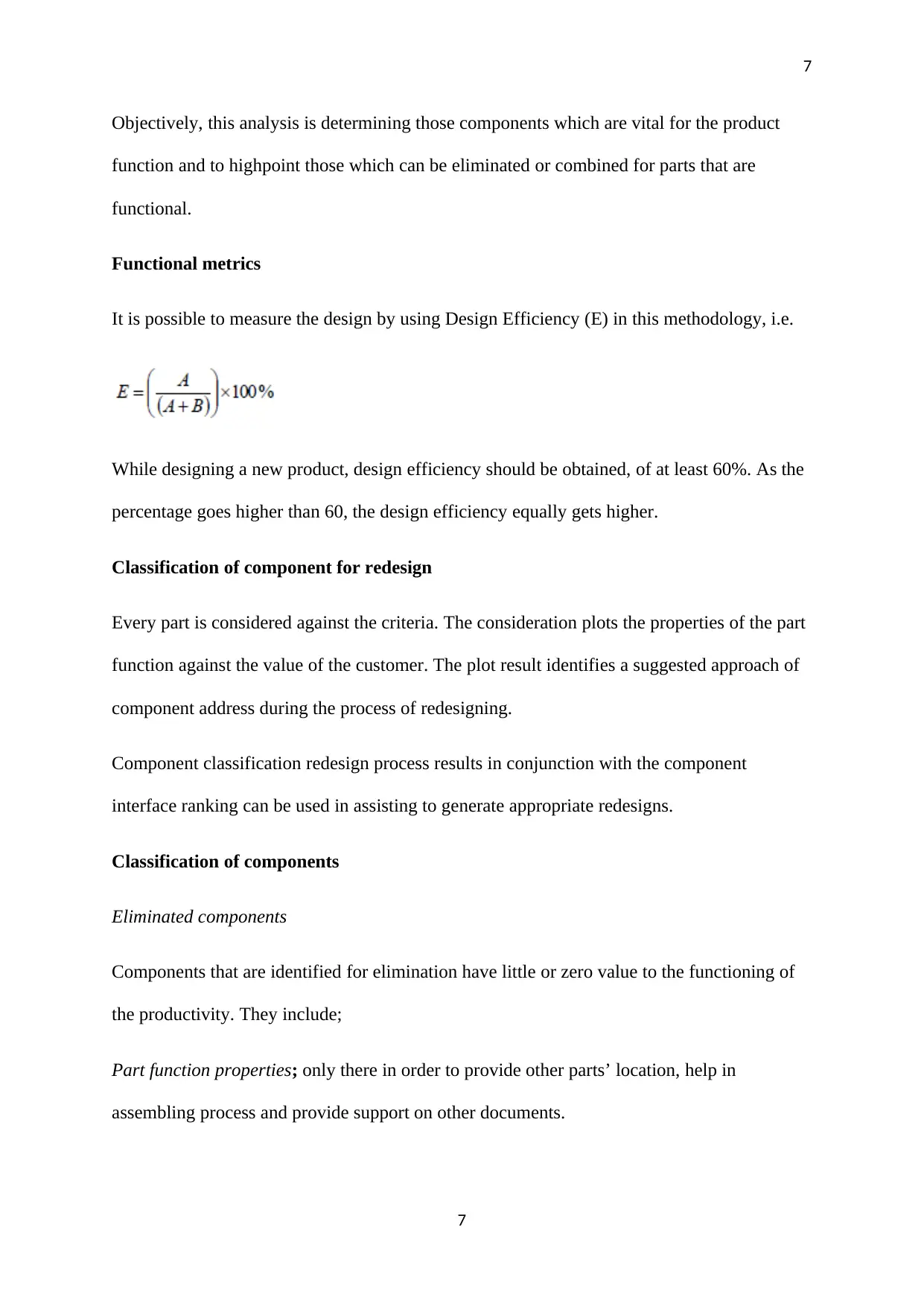
7
Objectively, this analysis is determining those components which are vital for the product
function and to highpoint those which can be eliminated or combined for parts that are
functional.
Functional metrics
It is possible to measure the design by using Design Efficiency (E) in this methodology, i.e.
While designing a new product, design efficiency should be obtained, of at least 60%. As the
percentage goes higher than 60, the design efficiency equally gets higher.
Classification of component for redesign
Every part is considered against the criteria. The consideration plots the properties of the part
function against the value of the customer. The plot result identifies a suggested approach of
component address during the process of redesigning.
Component classification redesign process results in conjunction with the component
interface ranking can be used in assisting to generate appropriate redesigns.
Classification of components
Eliminated components
Components that are identified for elimination have little or zero value to the functioning of
the productivity. They include;
Part function properties; only there in order to provide other parts’ location, help in
assembling process and provide support on other documents.
7
Objectively, this analysis is determining those components which are vital for the product
function and to highpoint those which can be eliminated or combined for parts that are
functional.
Functional metrics
It is possible to measure the design by using Design Efficiency (E) in this methodology, i.e.
While designing a new product, design efficiency should be obtained, of at least 60%. As the
percentage goes higher than 60, the design efficiency equally gets higher.
Classification of component for redesign
Every part is considered against the criteria. The consideration plots the properties of the part
function against the value of the customer. The plot result identifies a suggested approach of
component address during the process of redesigning.
Component classification redesign process results in conjunction with the component
interface ranking can be used in assisting to generate appropriate redesigns.
Classification of components
Eliminated components
Components that are identified for elimination have little or zero value to the functioning of
the productivity. They include;
Part function properties; only there in order to provide other parts’ location, help in
assembling process and provide support on other documents.
7
Paraphrase This Document
Need a fresh take? Get an instant paraphrase of this document with our AI Paraphraser
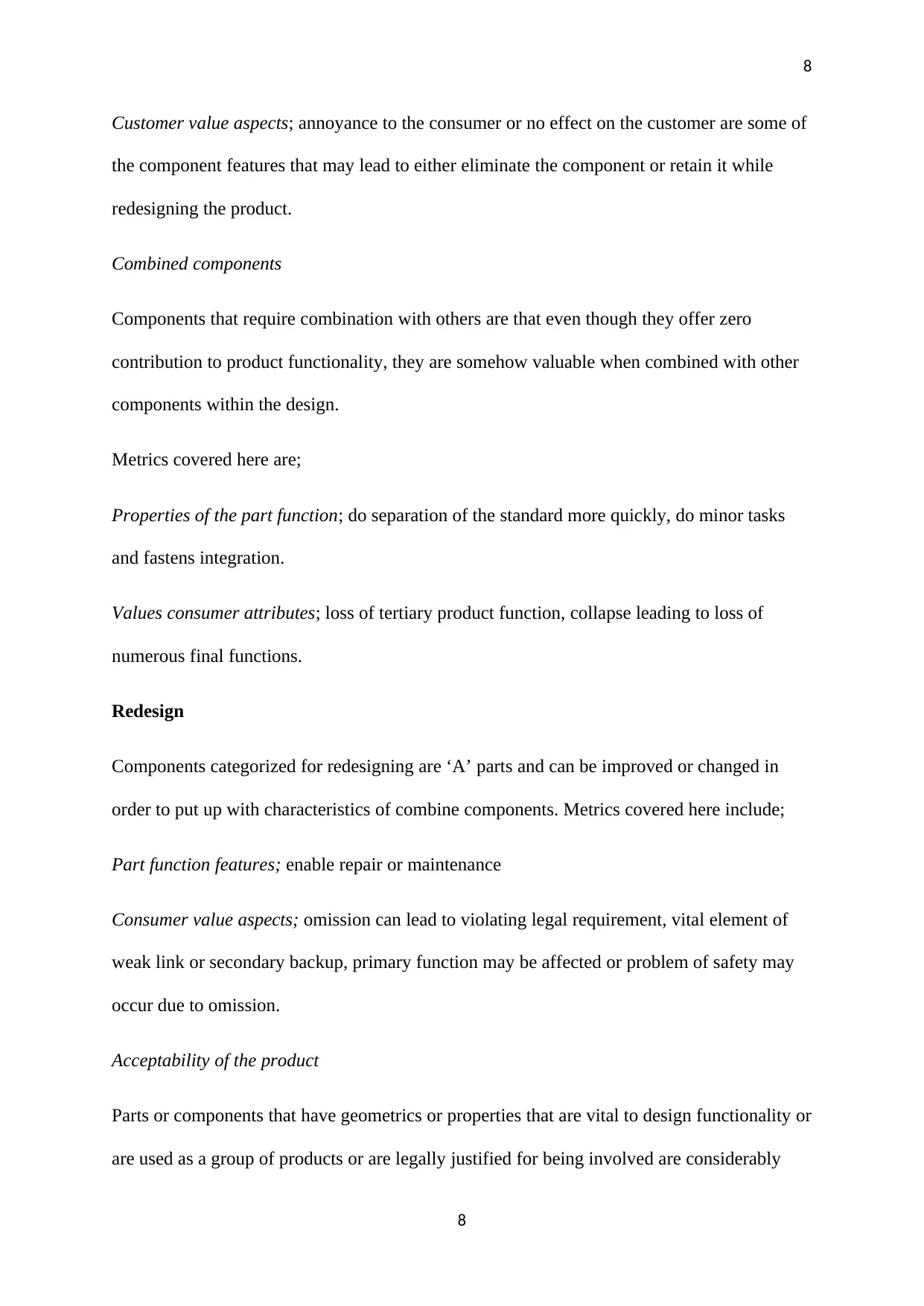
8
Customer value aspects; annoyance to the consumer or no effect on the customer are some of
the component features that may lead to either eliminate the component or retain it while
redesigning the product.
Combined components
Components that require combination with others are that even though they offer zero
contribution to product functionality, they are somehow valuable when combined with other
components within the design.
Metrics covered here are;
Properties of the part function; do separation of the standard more quickly, do minor tasks
and fastens integration.
Values consumer attributes; loss of tertiary product function, collapse leading to loss of
numerous final functions.
Redesign
Components categorized for redesigning are ‘A’ parts and can be improved or changed in
order to put up with characteristics of combine components. Metrics covered here include;
Part function features; enable repair or maintenance
Consumer value aspects; omission can lead to violating legal requirement, vital element of
weak link or secondary backup, primary function may be affected or problem of safety may
occur due to omission.
Acceptability of the product
Parts or components that have geometrics or properties that are vital to design functionality or
are used as a group of products or are legally justified for being involved are considerably
8
Customer value aspects; annoyance to the consumer or no effect on the customer are some of
the component features that may lead to either eliminate the component or retain it while
redesigning the product.
Combined components
Components that require combination with others are that even though they offer zero
contribution to product functionality, they are somehow valuable when combined with other
components within the design.
Metrics covered here are;
Properties of the part function; do separation of the standard more quickly, do minor tasks
and fastens integration.
Values consumer attributes; loss of tertiary product function, collapse leading to loss of
numerous final functions.
Redesign
Components categorized for redesigning are ‘A’ parts and can be improved or changed in
order to put up with characteristics of combine components. Metrics covered here include;
Part function features; enable repair or maintenance
Consumer value aspects; omission can lead to violating legal requirement, vital element of
weak link or secondary backup, primary function may be affected or problem of safety may
occur due to omission.
Acceptability of the product
Parts or components that have geometrics or properties that are vital to design functionality or
are used as a group of products or are legally justified for being involved are considerably
8
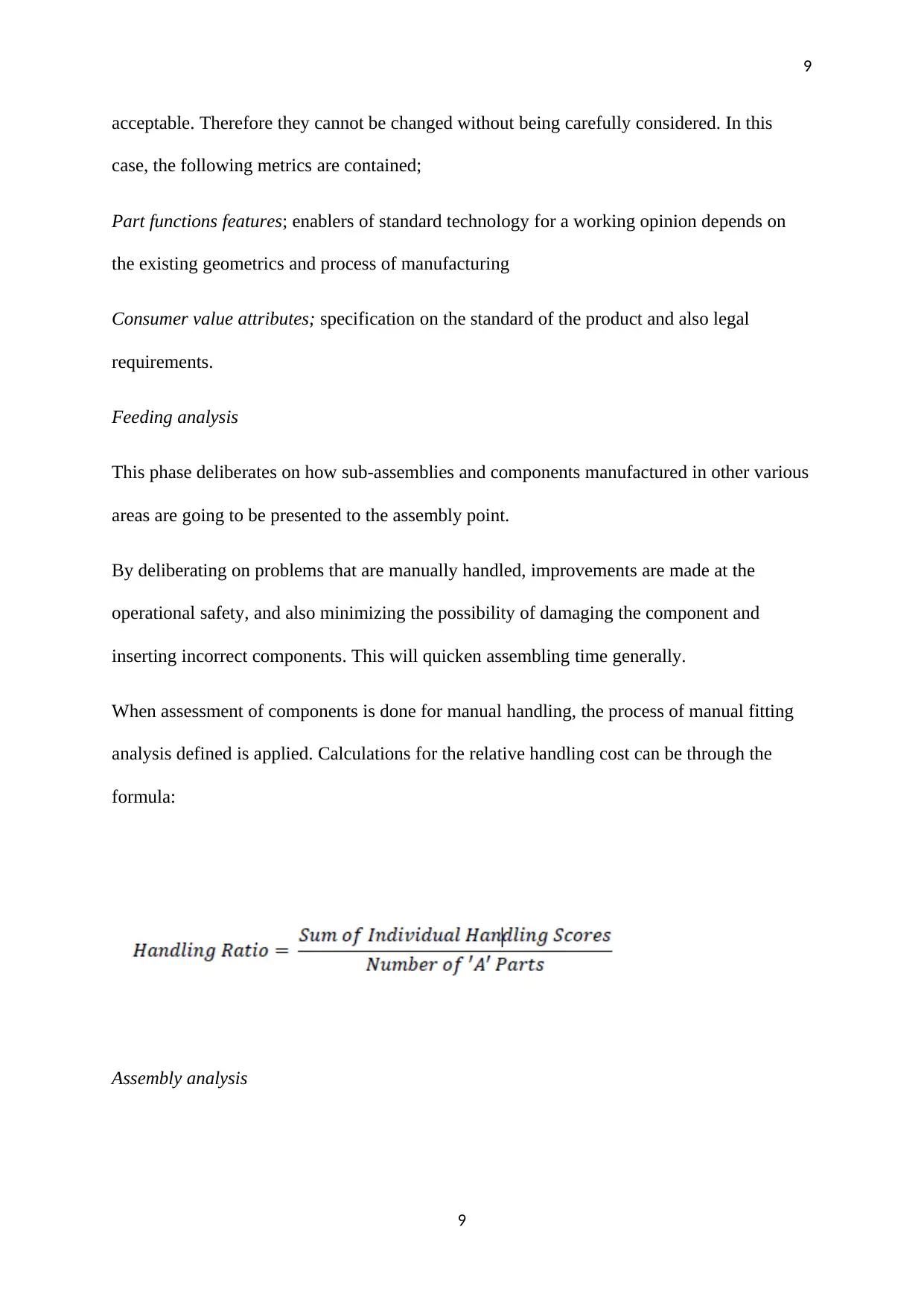
9
acceptable. Therefore they cannot be changed without being carefully considered. In this
case, the following metrics are contained;
Part functions features; enablers of standard technology for a working opinion depends on
the existing geometrics and process of manufacturing
Consumer value attributes; specification on the standard of the product and also legal
requirements.
Feeding analysis
This phase deliberates on how sub-assemblies and components manufactured in other various
areas are going to be presented to the assembly point.
By deliberating on problems that are manually handled, improvements are made at the
operational safety, and also minimizing the possibility of damaging the component and
inserting incorrect components. This will quicken assembling time generally.
When assessment of components is done for manual handling, the process of manual fitting
analysis defined is applied. Calculations for the relative handling cost can be through the
formula:
Assembly analysis
9
acceptable. Therefore they cannot be changed without being carefully considered. In this
case, the following metrics are contained;
Part functions features; enablers of standard technology for a working opinion depends on
the existing geometrics and process of manufacturing
Consumer value attributes; specification on the standard of the product and also legal
requirements.
Feeding analysis
This phase deliberates on how sub-assemblies and components manufactured in other various
areas are going to be presented to the assembly point.
By deliberating on problems that are manually handled, improvements are made at the
operational safety, and also minimizing the possibility of damaging the component and
inserting incorrect components. This will quicken assembling time generally.
When assessment of components is done for manual handling, the process of manual fitting
analysis defined is applied. Calculations for the relative handling cost can be through the
formula:
Assembly analysis
9
⊘ This is a preview!⊘
Do you want full access?
Subscribe today to unlock all pages.

Trusted by 1+ million students worldwide
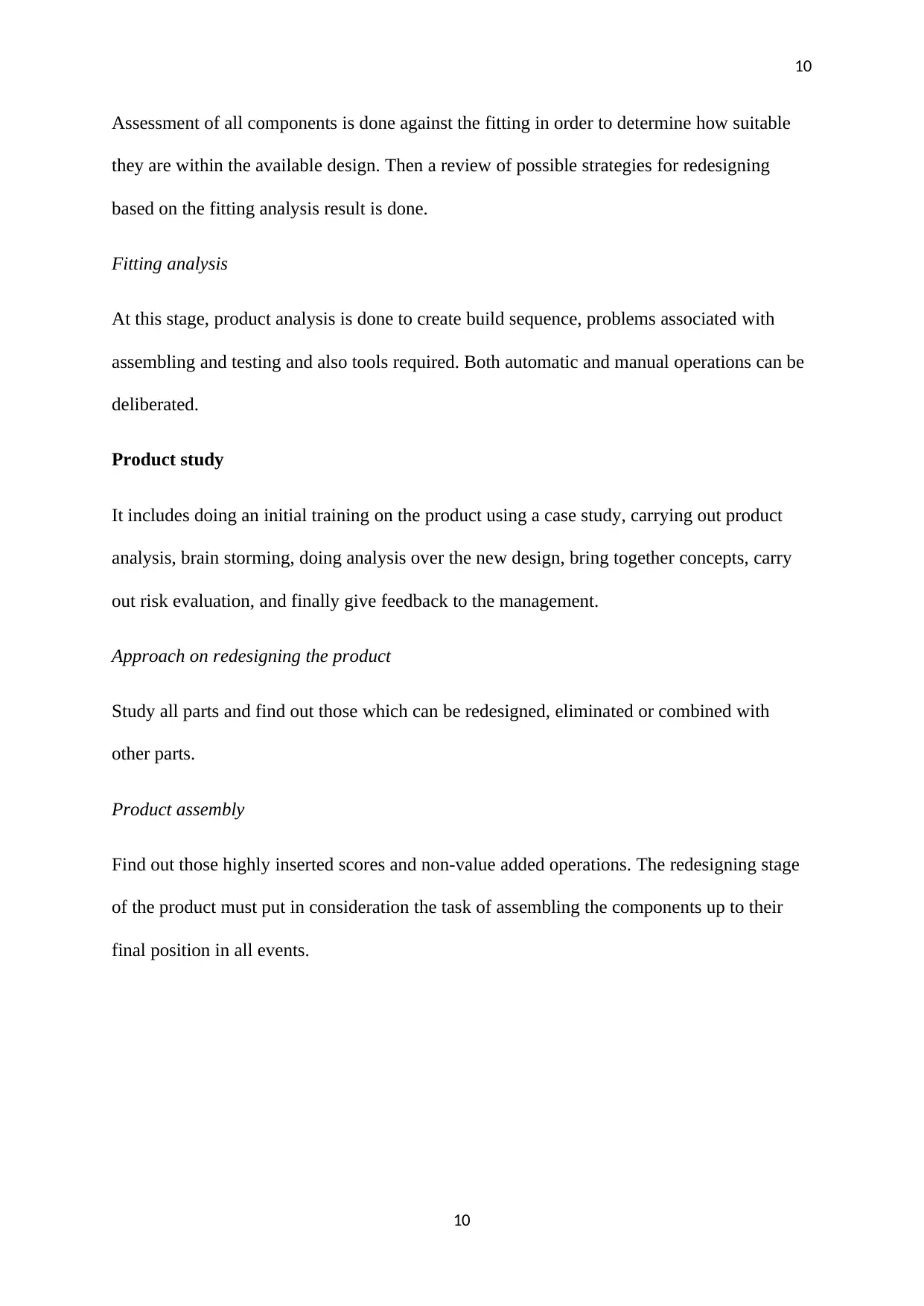
10
Assessment of all components is done against the fitting in order to determine how suitable
they are within the available design. Then a review of possible strategies for redesigning
based on the fitting analysis result is done.
Fitting analysis
At this stage, product analysis is done to create build sequence, problems associated with
assembling and testing and also tools required. Both automatic and manual operations can be
deliberated.
Product study
It includes doing an initial training on the product using a case study, carrying out product
analysis, brain storming, doing analysis over the new design, bring together concepts, carry
out risk evaluation, and finally give feedback to the management.
Approach on redesigning the product
Study all parts and find out those which can be redesigned, eliminated or combined with
other parts.
Product assembly
Find out those highly inserted scores and non-value added operations. The redesigning stage
of the product must put in consideration the task of assembling the components up to their
final position in all events.
10
Assessment of all components is done against the fitting in order to determine how suitable
they are within the available design. Then a review of possible strategies for redesigning
based on the fitting analysis result is done.
Fitting analysis
At this stage, product analysis is done to create build sequence, problems associated with
assembling and testing and also tools required. Both automatic and manual operations can be
deliberated.
Product study
It includes doing an initial training on the product using a case study, carrying out product
analysis, brain storming, doing analysis over the new design, bring together concepts, carry
out risk evaluation, and finally give feedback to the management.
Approach on redesigning the product
Study all parts and find out those which can be redesigned, eliminated or combined with
other parts.
Product assembly
Find out those highly inserted scores and non-value added operations. The redesigning stage
of the product must put in consideration the task of assembling the components up to their
final position in all events.
10
Paraphrase This Document
Need a fresh take? Get an instant paraphrase of this document with our AI Paraphraser
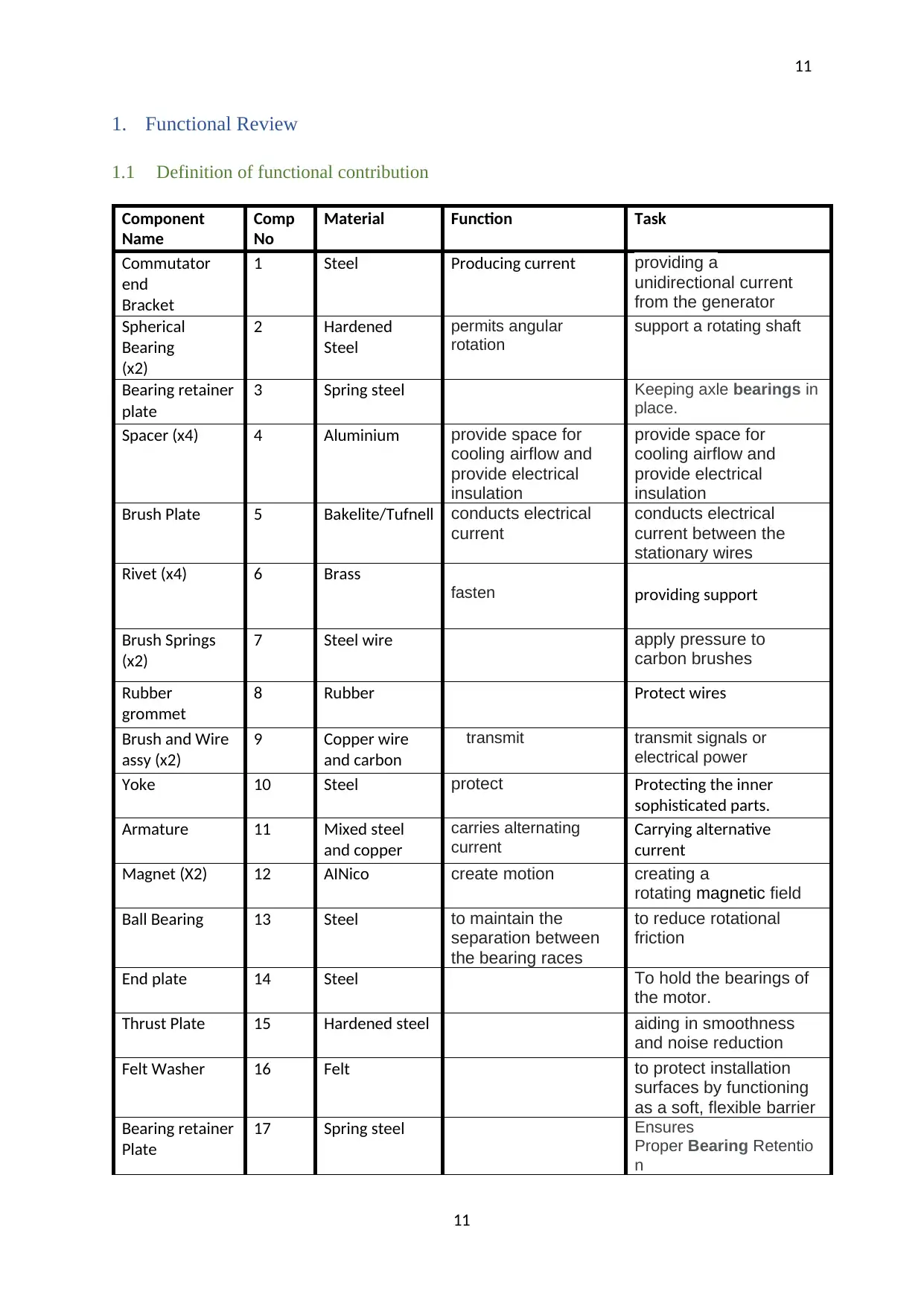
11
1. Functional Review
1.1 Definition of functional contribution
Component
Name
Comp
No
Material Function Task
Commutator
end
Bracket
1 Steel Producing current providing a
unidirectional current
from the generator
Spherical
Bearing
(x2)
2 Hardened
Steel
permits angular
rotation
support a rotating shaft
Bearing retainer
plate
3 Spring steel Keeping axle bearings in
place.
Spacer (x4) 4 Aluminium provide space for
cooling airflow and
provide electrical
insulation
provide space for
cooling airflow and
provide electrical
insulation
Brush Plate 5 Bakelite/Tufnell conducts electrical
current
conducts electrical
current between the
stationary wires
Rivet (x4) 6 Brass
fasten providing support
Brush Springs
(x2)
7 Steel wire apply pressure to
carbon brushes
Rubber
grommet
8 Rubber Protect wires
Brush and Wire
assy (x2)
9 Copper wire
and carbon
transmit transmit signals or
electrical power
Yoke 10 Steel protect Protecting the inner
sophisticated parts.
Armature 11 Mixed steel
and copper
carries alternating
current
Carrying alternative
current
Magnet (X2) 12 AINico create motion creating a
rotating magnetic field
Ball Bearing 13 Steel to maintain the
separation between
the bearing races
to reduce rotational
friction
End plate 14 Steel To hold the bearings of
the motor.
Thrust Plate 15 Hardened steel aiding in smoothness
and noise reduction
Felt Washer 16 Felt to protect installation
surfaces by functioning
as a soft, flexible barrier
Bearing retainer
Plate
17 Spring steel Ensures
Proper Bearing Retentio
n
11
1. Functional Review
1.1 Definition of functional contribution
Component
Name
Comp
No
Material Function Task
Commutator
end
Bracket
1 Steel Producing current providing a
unidirectional current
from the generator
Spherical
Bearing
(x2)
2 Hardened
Steel
permits angular
rotation
support a rotating shaft
Bearing retainer
plate
3 Spring steel Keeping axle bearings in
place.
Spacer (x4) 4 Aluminium provide space for
cooling airflow and
provide electrical
insulation
provide space for
cooling airflow and
provide electrical
insulation
Brush Plate 5 Bakelite/Tufnell conducts electrical
current
conducts electrical
current between the
stationary wires
Rivet (x4) 6 Brass
fasten providing support
Brush Springs
(x2)
7 Steel wire apply pressure to
carbon brushes
Rubber
grommet
8 Rubber Protect wires
Brush and Wire
assy (x2)
9 Copper wire
and carbon
transmit transmit signals or
electrical power
Yoke 10 Steel protect Protecting the inner
sophisticated parts.
Armature 11 Mixed steel
and copper
carries alternating
current
Carrying alternative
current
Magnet (X2) 12 AINico create motion creating a
rotating magnetic field
Ball Bearing 13 Steel to maintain the
separation between
the bearing races
to reduce rotational
friction
End plate 14 Steel To hold the bearings of
the motor.
Thrust Plate 15 Hardened steel aiding in smoothness
and noise reduction
Felt Washer 16 Felt to protect installation
surfaces by functioning
as a soft, flexible barrier
Bearing retainer
Plate
17 Spring steel Ensures
Proper Bearing Retentio
n
11
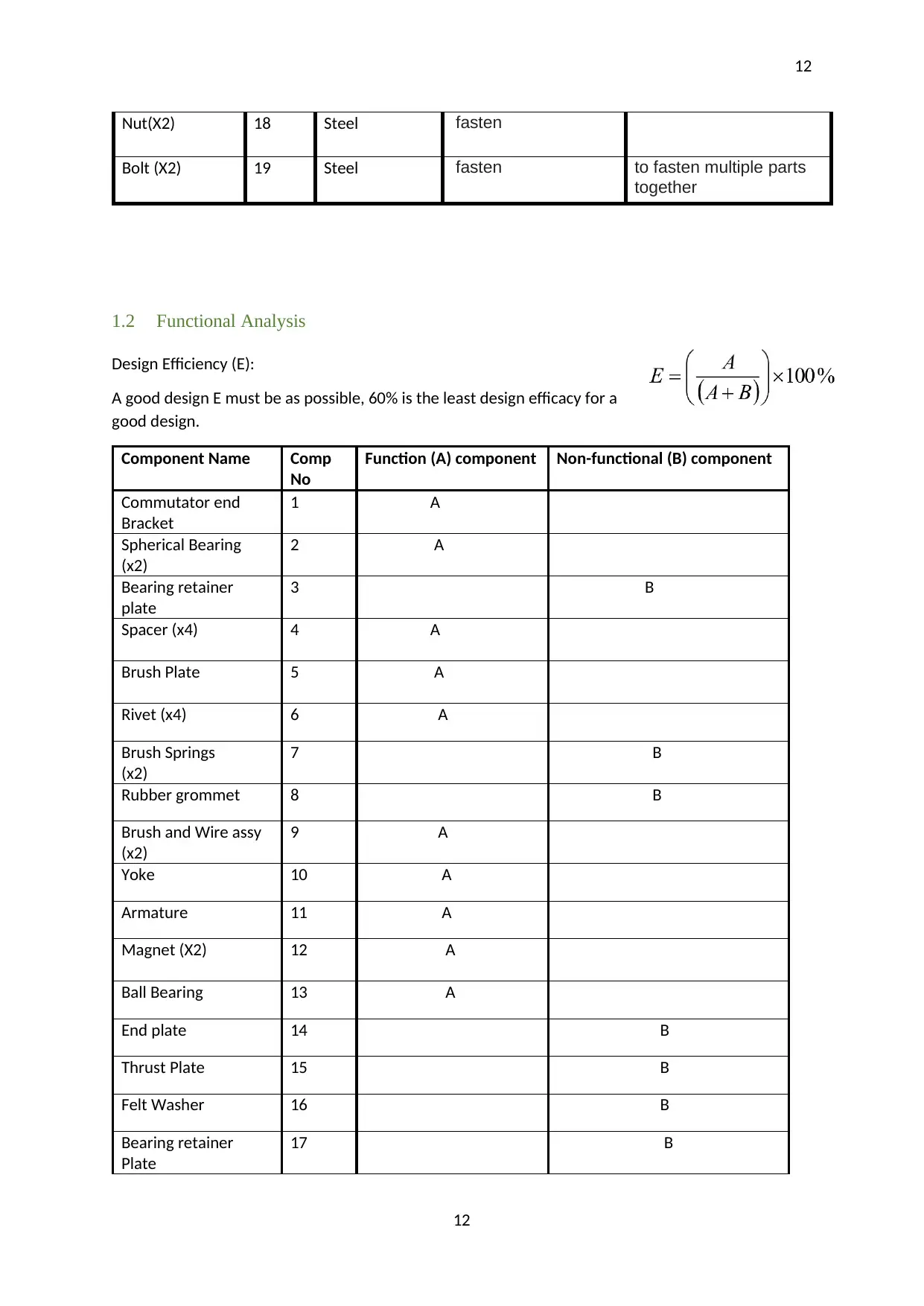
12
Nut(X2) 18 Steel fasten
Bolt (X2) 19 Steel fasten to fasten multiple parts
together
1.2 Functional Analysis
Design Efficiency (E):
A good design E must be as possible, 60% is the least design efficacy for a
good design.
Component Name Comp
No
Function (A) component Non-functional (B) component
Commutator end
Bracket
1 A
Spherical Bearing
(x2)
2 A
Bearing retainer
plate
3 B
Spacer (x4) 4 A
Brush Plate 5 A
Rivet (x4) 6 A
Brush Springs
(x2)
7 B
Rubber grommet 8 B
Brush and Wire assy
(x2)
9 A
Yoke 10 A
Armature 11 A
Magnet (X2) 12 A
Ball Bearing 13 A
End plate 14 B
Thrust Plate 15 B
Felt Washer 16 B
Bearing retainer
Plate
17 B
12
Nut(X2) 18 Steel fasten
Bolt (X2) 19 Steel fasten to fasten multiple parts
together
1.2 Functional Analysis
Design Efficiency (E):
A good design E must be as possible, 60% is the least design efficacy for a
good design.
Component Name Comp
No
Function (A) component Non-functional (B) component
Commutator end
Bracket
1 A
Spherical Bearing
(x2)
2 A
Bearing retainer
plate
3 B
Spacer (x4) 4 A
Brush Plate 5 A
Rivet (x4) 6 A
Brush Springs
(x2)
7 B
Rubber grommet 8 B
Brush and Wire assy
(x2)
9 A
Yoke 10 A
Armature 11 A
Magnet (X2) 12 A
Ball Bearing 13 A
End plate 14 B
Thrust Plate 15 B
Felt Washer 16 B
Bearing retainer
Plate
17 B
12
⊘ This is a preview!⊘
Do you want full access?
Subscribe today to unlock all pages.

Trusted by 1+ million students worldwide
1 out of 20
Related Documents
Your All-in-One AI-Powered Toolkit for Academic Success.
+13062052269
info@desklib.com
Available 24*7 on WhatsApp / Email
![[object Object]](/_next/static/media/star-bottom.7253800d.svg)
Unlock your academic potential
Copyright © 2020–2025 A2Z Services. All Rights Reserved. Developed and managed by ZUCOL.





